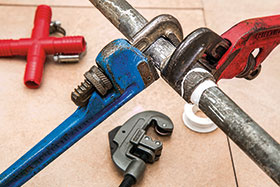

Without a maintenance contract, customers are opening themselves up to myriad problems.
Is maintenance of security systems really necessary? The answer to this could be provided by looking at the analogy of buying a new motor vehicle. The service plan that is provided with your vehicle ensures that the requisite parts are replaced at specified intervals to guarantee that your vehicle remains operational. By logical deduction therefore, the answer to the necessity of security system maintenance is a resounding yes, but only if you want your system to continue monitoring and alerting you to unusual or unwanted behaviour.

Dewald Burger of BT-SA says that maintenance is definitely a hard sell, but without a maintenance contract in place, customers are opening themselves up to a myriad problems. He says that because security systems are put in place to protect both people and property, any breakdown in the system allows for breaches to take place. There is simply no ideal time for a security system to fail.
The attitude towards maintenance contracts, he says, is similar to that harboured towards insurance. It is typically viewed with distaste and resentment. Customers, however, need to understand that the cost of replacing components or systems once a security solution has failed, is far higher than the cost of scheduled preventative maintenance. The trend, he claims is therefore for companies to commit to a maintenance contract after a breakdown has occurred. The ideal, of course, is to institute the scheduled maintenance programme simultaneously with the provision of a service level agreement (SLA).
Andre Meintjes of Bitz Technologies says that a strong selling point for maintenance contracts is the fact that the company is able to provide a team of specialised CCTV and IP technicians, who are skilled in their areas of expertise and who are completely up to date on current technology. This eliminates the customer needing to invest unnecessary outlay on staffing up with their own technicians, who would probably only be busy for a portion of the time and who generally would not have the best practice skills sets a service provider can supply.
Nick Grange of C3 Shared Services says that the best return on investment for customers is an optimally running security system, with all cameras up and running to their specified ability and capability. This is also particularly relevant to IP platforms, specifically where the larger platforms are provided with patches and regular upgrades. If customers choose not to sign up for a maintenance contract, they run the risk of not only having the system fail at some stage but they also compromise backwards compatibility.
What should be included in a maintenance contract?
All interviewees agree that the maintenance contract should be customised to suit the customer’s specific needs. However, standard packages that address basic elements like checking whether the lens is clean and in focus, and addressing any damage to equipment, are available.
Ambient environment plays a big role in the development of a contract. For instance, in coastal areas, lens cleaning and checking of corrosion on camera housings would be more pertinent than in areas where saltwater laden air is not an issue. Similarly, in consistently windy conditions, it would be necessary to factor in the regular checking of camera angles.

These contracts can be scheduled to provide preventative maintenance on a bi-monthly, monthly, quarterly or bi-annual basis. Customised contracts could include network analysis, especially on IP networks, as well as checking of channels and virtual equipment. Burger says that the company also includes features such as checking of the control room in terms of cabling and monitors, to ensure that the communication between the in-field cameras and the control room is not compromised.
Grange says that C3 employs a maintenance team comprising a technical manager with a number of technicians. In general, the technicians would be responsible for the more basic maintenance functions while the manager would be involved in software changes and upgrades, upgrades on firmware and reporting. He adds that the company has bronze, gold and platinum contracts, with increasing levels of support associated with each package. For example, on the bronze package, any after-hours work would be billed separately, whilst the platinum package includes all reasonable work required, depending on availability of spares.
He suggests breaking the site up into critical and non-critical areas and designing maintenance around these zones. In addition to critical areas within a specific site, he says that some applications require an overall more critical approach than others. He cites a platinum mine or financial institution as requiring 24/7 uptime on equipment whereas a residential or business park would generally have a secondary camera that could fulfil a similar role to a failed camera.
Detailed SLA
The compilation of a detailed SLA will provide a contractual understanding of the specific terms of the maintenance element and will ensure that the customer is protected with regard to their investment. The SLA should include the scheduled maintenance periods, whether after-hours work is included in the contract, the exact turnaround time on service, and whether spares are included. It will also carefully detail the individual elements included in each maintenance session and describe what measures will be taken to ensure maximised system uptime.
Meintjes suggests including a health monitoring system. This allows the service provider to receive alerts when any issues arise, even when preventative maintenance is in place. In these instances a fast turnaround time is guaranteed and possible downtime is avoided. Immediate reaction to a problem is possible even before the client is aware of a problem. With reaction faster than the standard four to eight hours should be specified to provide customers with complete assurance that the system will not fail.
Grange adds that software upgrades should be included as part of the maintenance contract to keep the system current and to provide sustainability of the system over its lifetime. In addition, the service provider should provide a list of the guaranteed availability of mission critical spares.
With economic pressures bearing heavily on both small and large organisations, there is a trend to cut what are deemed as unnecessary costs. Unfortunately maintenance is one of the victims of this malady and decisions are often taken solely on perceived cost considerations. All interviewees concur that while it is tempting for customers to undertake their own main-tenance on security systems this is not advisable for a number of reasons.
The skills question
Reputable service providers commit substantial investment to upskilling their technicians in current technology. This ensures that the technicians are capable of repairing or upgrading each system supplied and/or installed by the company. Meintjes says that even in larger customer organisations, where they employ their own CCTV technician, there is little possibility that the technician has the same skills set as a service provider’s maintenance team.
Burger says that the customer needs to acknowledge that security system maintenance is not their core business and that benefits are to be derived from leveraging the knowledge and experience that system integrators have garnered over many installations. In addition, equipment suppliers work closely with system integrators to integrate smart maintenance and upgrades into systems, thus providing customers with cutting edge, up-to-date solutions.
The general feeling is that a maintenance contract should be regarded not as an expense, but rather as an investment, since breakdowns or underperformance can be very costly. Scheduled, preventative maintenance should be carefully specified in the SLA to ensure that customers are protected at all times.

© Technews Publishing (Pty) Ltd. | All Rights Reserved.